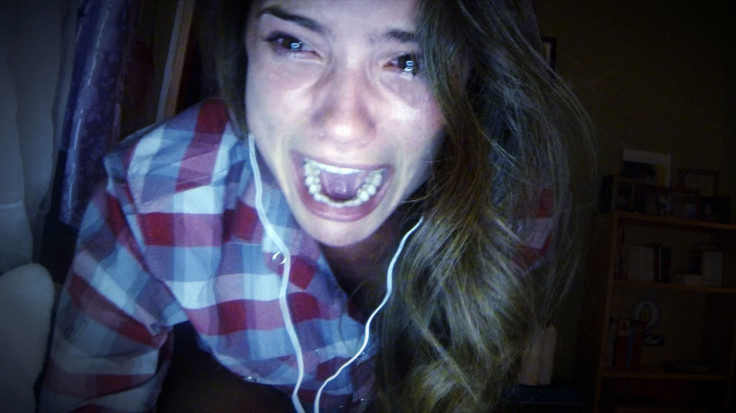Horror Movies 2015: SXSW Hits ‘Unfriended,’ ‘Pod’ Show Home Is Where The Haunting Is

Several classic horror films start with a shot of a quiet, ordinary home. It’s a peaceful and welcoming sight that is soon terrorized or destroyed at the hands of unseen forces or intruders. Home is no longer a safe place, and in horror movies, it hasn’t been for a long time. At a festival rich in horror films, South by Southwest has several different topics to screen, but one in particular continues to crop up year after year: Home is where the haunting is.
The steady stream of bloody SXSW movies has its roots in the Austin genre scene. In the fall, the city plays host to one of the largest genre festivals in the country, Fantastic Fest, and the popular chain of Alamo Drafthouse Cinemas keeps the gore flowing year-round. Because SXSW’s local cinephile crowd is so entrenched in the horror scene, it’s not a surprise to find the quality of their programming is meticulously above most major festivals and prefers to book messed-up movies such as "We Are Still Here" and "Pod."
Levan Gabriadze's “Unfriended” takes the home invasion concept to the laptop level. After the suicide of a bullied girl, her friends receive a strange Skype call as they are killed off one by one, visible to each other. Bringing “The Final Destination” to a computer, “Unfriended” keeps its viewers engaged, observing every detail as the screen is essentially hacked and the user loses control. This operates on a different level of horror, because the home screen is a familiar place that is no longer safe.
Ted Geoghegan’s “We Are Still Here” taps into the frightening haunted history of “The Amityville Horror” and “Poltergeist.” A grieving couple, Paul (Andrew Sensenig) and Anne (Barbara Crampton), move to a sleepy New England hamlet where they realize the home they sought for peace is filled with spirits demanding human sacrifice. The decimation of the home into a bloodbath contradicts its postcard setting and it’s characters' innocent intentions as if to say, "It could happen to anyone."
Likewise, Mickey Keating’s “Pod” finds two estranged siblings Ed (Dean Cates) and Lyla (Lauren Ashley Carter) tenuously reconnecting to check up on their war veteran brother, Martin (Brian Morvant), after he leaves them a cryptic message about the government. Just as in “We Are Still Here,” "Pod’s" horror takes place within the four walls that are supposed to make a safe haven.
Director Mickey Keating discussed his reason to set “Pod” in a home: “There’s nothing more disturbing than walking into something you’re familiar with, whether that’s a place where you grew up or a place where you had fond memories in, and see it completely destroyed.... There’s something violating about seeing something you know is supposed to be normal or beautiful.”
“To me, the kitchen is such a symbol of gathering and community. To have characters at odds with one another in those kitchens is not necessarily what you expect,” Keating added. “There’s nothing worse than when you are at a dinner party and someone’s fighting with another person at the dinner party. Anything I could do to push that sense of unsettling of domestic life further.”
“Also, there’s nothing grosser [sic] than seeing a bunch of rusted tools and filth in a kitchen. It’s so unsettling,” he added. “Martin creates this battle plan with the ground floor as his fortress. We made it very purposeful that the upstairs were skeletal. He thinks the government is going to come and crash through his doors, so he’s going to have 50 plans of escape there than up[stairs].”
Although much of pre-1960s horror dealt with the supernatural or fantastical creatures of the night, the Cold War began to instill a fear of America’s surroundings and its neighbors. Who was safe to trust when the Russians were coming? The sci-fi classic “Invasion of the Body Snatchers” was the most prominent example, but William Castle’s “13 Ghosts” introduced the idea of inheriting ghosts with a new home. Even family heirlooms were not to be trusted.
Starting in the ’60s and ’70s, the post-hippie crash introduced one bad trip after another. “Rosemary’s Baby” was as equally about the occult as it was the neighbors and husband who sell Rosemary to the devil. Children weren’t safe from evil spirits in “The Exorcist” and “Poltergeist.” The “Halloween” and “Nightmare on Elm Street” franchise popped the suburban bubble of safety for kids who knew nothing of locking their front door or walking down the street at night.
From “Scream,” “Funny Games” and “The Ring,” domestic terror took on different faces to make its viewers feel unsafe at home alone at night. “The Purge” brought outside political milieu into one family’s home as they attempted to save a persecuted stranger. Director Adam Wingard particularly likes to play with this concept in his films such as SXSW alum “You’re Next” (in which a fatal home invasion begins during a family reunion) and “The Guest” (which features a stranger coming into a family's home after claiming he knew their war veteran son). In “It Follows,” a group of teenagers' quiet suburbia is disrupted by a ghoulish monster that never leaves its victims until they die.
Horror is sometimes used as a way to work through cultural fears and social phobias. The concept of home as a place of safety and family is a prime target to terrorize because of its universality and how easily it is for us to feel threatened. Just by having a stranger enter your home, be it Freddy, Jason or an alien pod, you have the basic premise of a nightmare. As these recent SXSW movies show, it isn’t going away anytime soon but rather will have more directors toying with our fears through the places we call home.
© Copyright IBTimes 2025. All rights reserved.






















